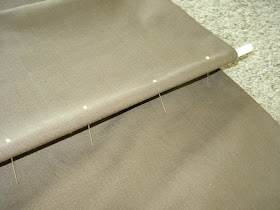
I made four covers to go over some existing pillows using the leftovers from my blind project. I then made two more "basket weave" pillows to accent with. They are so pretty! My pictures really don't do them justice. Isn't the basket weave divine?

So... do you want to make your own?
Supplies:
fabric (I got one yard to make two pillows and had some left over.)
ribbon (I used three spools of sheer ribbon per pillow but it will depend on the size of your pillow.)
pillow form
sewing notions

Step 1: Cut out a piece of fabric for the face several inches larger than your pillow form. You want to consider the fullness of your pillow and hem allowance.
Step 2: Cut out two more pieces the same width and about 3/4 of the length of your face fabric.
Step 3: Starting in one direction pin your ribbon in strips next to each other, pinning on both ends till you cover the entire piece.
Step 4: Start weaving by taking strips of ribbon and place them over, under, over, under... in the opposite direction. You will alternate every other strip. Once it is in place, tuck it next to the edge (or previous ribbon) and pin both ends. (I'm sure all of you know how to weave but I'm trying to make this thing thorough, but man its hard to explain in words!)
Step 5: Sew a top stitch as close to the edge as possible in order to hold everything in place while you work with it. Then trim around the piece. (At this point you could take some binding tape and bind the edge to make a beautiful place mat)
Step 6: Take your other fabric pieces and turn over and sew one of the edges. You may need to trim these pieces as well depending on how much you trimmed your face piece.
Step 7: Place the right sides together with the two back pieces overlapping. The turned edges should be in the center. Pin in place.
Step 8: Sew all around your pillow. Once done, clip the corners so they will be sharp when turned.
Step 9: Turn your cover right side out and stuff your pillow in. You may need to adjust the ribbon when done. And there you have it!
Note: the other pillow covers where made the using the same method as above.

Simply beautiful!














